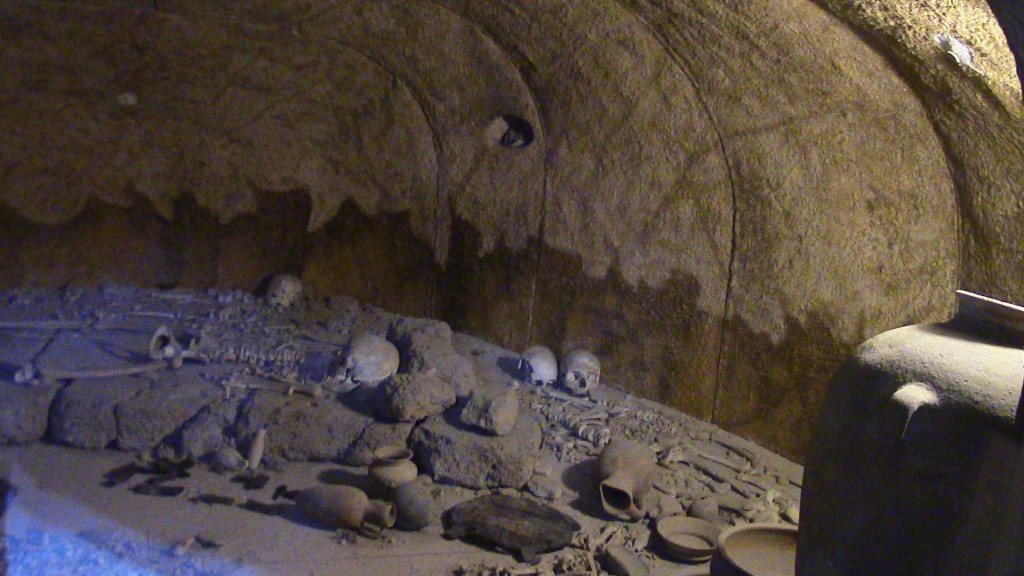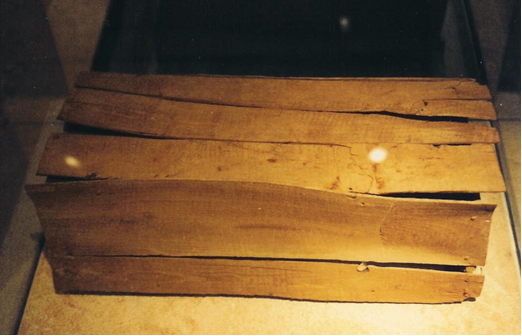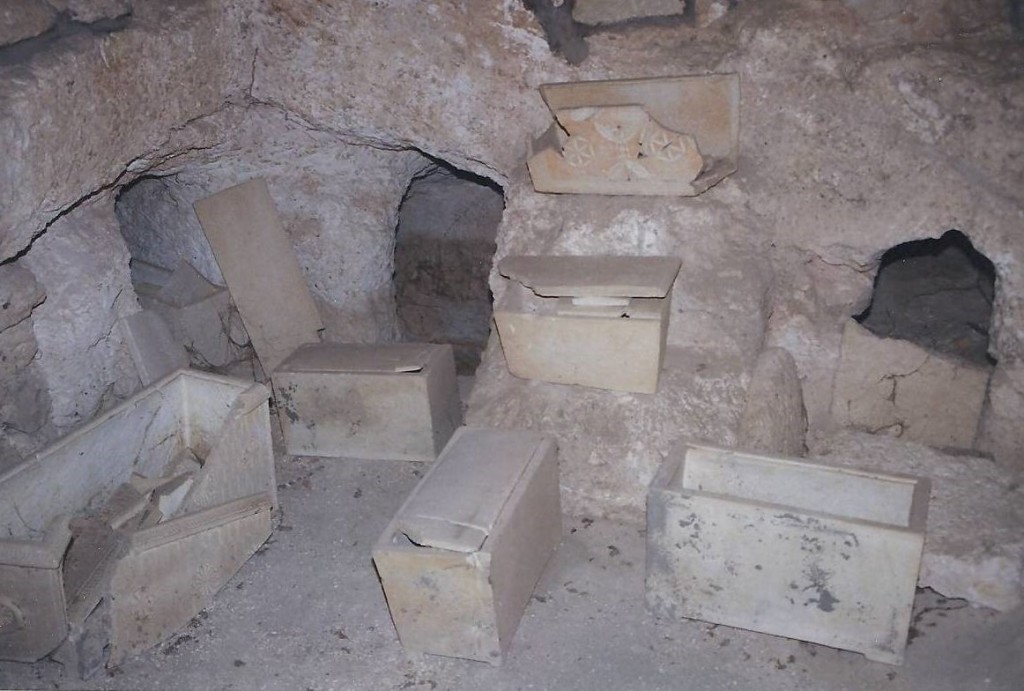09.04.02 Lk. 9:59-62; (See also Mt. 8:21-22)
“LET THE DEAD BURY THEIR OWN DEAD”
A 59 Then He said to another,
“Follow me.”
B “Lord,” he replied, “first let me go
C bury my father.”
C’ 60 But He told him, “Let the dead bury their own dead,
B’ but you go
A’ and spread the news of the kingdom of God.”
61 Another also said, “I will follow you, Lord; but first let me go and say good-bye to those at my house.” 62 But Jesus said to him, “No one who puts his hand to the plow and looks back is fit for the kingdom of God.”
Literary style. Lines A and A’ are similar in that to follow Jesus is to proclaim the Kingdom of God. Lines B and B’ both reflect the command “go.” The first is to go and bury a father and the second is to go and proclaim the Kingdom of God. Lines C and C’ refer to the burial customs of the day, but Jesus told the man to give that responsibility to someone else. This is a typical Hebraic “Chiastic literary structure,”[1]
There were three kinds of bone-gathering in the last century or century and a half of the second temple period:
- The met mizvah, or the burial of bones of a criminal who did not deserve proper interment.[2]
- The gathering of human bones that were occasionally found outside of tombs.[3]
- The common family practice of burial.[4]
The discussion Jesus had referred to the common practice of burial of the dead. In that context, the phrase “Let the dead bury their own dead,” is unique as well as problematic. The mystery lies in the fact that the statement portrays Jesus as one who breaks the 5th commandment concerning the lack of honor due to one’s parents, which was highly inconsiderate and uncompassionate. Others have suggested that Jesus was stating that the “spiritually” dead should bury the “physically” dead. While this is true, it does not address the problem of disrespect. Since a word study does not clarify this, a cultural explanation must be sought.
The burial custom varied greatly from the early Old Testament era to the days of Jesus. Embalming was never practiced with the exception of Jacob and Joseph, who were probably mummified. Burial was on the same day of death, due primarily to the rapid decay of a corpse in the hot climatic region of the Middle East. It appears that the earliest burials were in individual graves. Three examples are:
- Aaron was buried on Mt. Hor
- Moses was buried in a valley in the land of Moab
- Rebekah’s nurse, Deborah was buried near an oak tree
Eventually, families had family tombs that were carved from caves and when a person died, the body of the deceased was placed in the family burial chamber of a tomb.[5] Over time there was a large pile of bones that became known as a charnel pile.[6] For this reason, there are expressions such as “bury me with my fathers” (i.e., Gen. 49:29) or “sleep with your fathers” (i.e. Deut. 31:16).
The collection of bones became a matter of utmost care after Ezekiel prophesied that one day God would restore flesh upon the bones of the deceased (Ezek. 37:1-14).[7] But by the first century there was a two-step process of burial.
- The body was laid in a niche of a shaft tomb on the day of death where it decayed.[8]
- Approximately a year later the bones were gathered and placed in a box called an ossuary.[9] Only then was the burial considered complete. It is noteworthy to mention that the rabbis taught that the flesh had to decay in order to obtain forgiveness.[10] However, some scholars believe that this is a later rabbinic teaching.

09.04.02.A. A RECONSTRUCTED FAMILY CAVE-TOMB. This reconstructed cave-tomb at the Rockefeller Museum in East Jerusalem depicts the phrase “he slept with his fathers.” It reflects the burial custom typical of the Old Testament. But by the first century, the deceased were placed in a different type of family tomb and, after a year, the bones were gathered into a bone box known as an ossuary. Photograph by the author.
After the Greek conquest, wealthy Jewish people used Greek style graves, which were uniquely different from the common graves. It is believed that at some point after the Maccabean Revolt that the custom of collecting the bones of the deceased and placing them in a box came into practice.[11]
But in the days of Jesus, as it was in centuries past, the eldest son was responsible that his parents were properly cared for in their old age and in death and that there was an honorable parent’s funeral.[12] That included the application of spices and perfumes just as today flowers are presented in honorarium.[13] When the man said, “Lord, first let me go and bury my father,” he may have been addressing one of two situations.[14]
- He was the oldest son and as such was responsible for the care of both of his parents. If the eldest son could not care for his parents, he was obligated to assign his responsibility to someone who could. This was demonstrated when Jesus was dying on the cross and He, as the oldest son, passed His responsibility to John when He said to His mother, “Dear woman, here is your son.” To John He said, “Here is your mother” (Jn. 19:26-27). In the parable the disciple may have simply stated that he had responsibilities to his parents, who probably were elderly at the time, and hence, a concern to him.
Honor and respect of parents and elders has always been a core value at the heart of the Jewish faith. It was a sacred duty (Micah 7:6) for the eldest son to care for his elderly parents and to bury them when they died. Failure to do so resulted in incredible condemnation. Josephus referred to the law concerning the passing of one’s parents, they,
Should be honored immediately after God himself, and delivers that son who does not requite them for the benefits he has received from them, but is deficient on any such occasion, to be stoned.
Josephus, Against Apion 2:28 (206)
- It was the custom that a person’s body is to be buried on the day of death in a family tomb where it would decompose.[15] This was followed by a week of intense mourning known as shiv’ah, followed by another but less intense mourning period known as shloshim.[16] A year later the bones were carefully collected by the eldest son, placed in an ossuary (bone box), and reburied. In the discussion that Jesus had, the man’s father appears to have died in the past year but the burial process was not completed until the bones were collected. Only then was the rite of burial complete. However, if his father had recently died and the family was still in mourning, this conversation would not have taken place.
When Jesus said, “Let the dead bury their own dead,” He meant that someone else in the family should assume the responsibility of parental care and honor. Jesus called him with all due respect to his parents. The cost of following Jesus is not always easy.[17] Jesus was again saying that priorities of life must be correct: serving Him takes precedence over cultural and family norms and affections.
The core issue that was difficult for the disciples to understand, was that to be a follower of Jesus they had to surrender themselves unconditionally to the will of God. Furthermore, they had to devote themselves unconditionally to the work of the Kingdom without any lingering connections to the world they left behind. In essence, His command for them not to take anything along was a physical picture of their future spiritual ministry. This was the same message given when Jesus sent out seventy disciples (Lk. 10:1-16).

09.04.02.B. A WOODEN OSSUARY. After the Maccabean Revolt it was the custom was that after a person died, the body was placed in a tomb and a year later, after the flesh decayed, the family gathered the bones and placed them in a bone box called an ossuary. Photographed by the author at the Hecht Museum, University of Haifa.
The custom to which Jesus most likely referred to was preserved in the Jerusalem Talmud. Note the following passage:
When the flesh had wasted away, the bones were collected and placed in small chests called ossuaries. After the flesh had gone from the bones, and the bones were placed in the ossuaries, the son stopped mourning.
Jerusalem Talmud, Quantan 1:5[18]
It should be noted that not all peasant families could even afford a wooden ossuary. Often a body was buried in a grave and covered with dirt and stone.[19] Burial customs varied from region to region. However, in Israel, and especially in Jerusalem, the degree of wealth determined whether one’s bones would be placed in a stone ossuary or a wooden one.[20] But this burial custom ended with the destruction of the temple, although a few have been found dating to the third century (A.D.).[21] A few wooden ones were found near the desert oasis of Jericho where they would have endured centuries of dryness; wooden bone boxes in the mountain regions of Jerusalem or Galilee would not have survived centuries of damp winters.[22]

09.04.02.C. LIMESTONE OSSUARIES IN A FAMILY TOMB. Limestone ossuaries are shown as they were discovered in a first century tomb. Wealthy families used stone ossuaries to store the bones of their dead whereas common peasants used wooden ossuaries. Photo courtesy of Israel Antiquities Authority.
“No one who puts his hand to the plow.” Jesus again made a reference to the commitment His disciples were expected to make. The phrase refers to the call of Elisha (892-832 B.C.) and the decision he made to become a disciple of the prophet Elijah. The account is as follows,
19 Elijah left there and found Elisha son of Shaphat as he was plowing. Twelve teams of oxen were in front of him, and he was with the twelfth team. Elijah walked by him and threw his mantle over him. 20 Elisha left the oxen, ran to follow Elijah, and said, “Please let me kiss my father and mother, and then I will follow you.”
“Go on back,” he replied, “for what have I done to you?”
21 So he turned back from following him, took the team of oxen, and slaughtered them. With the oxen’s wooden yoke and plow, he cooked the meat and gave it to the people, and they ate. Then he left, followed Elijah, and served him.
1 Kings 19:19-21
Elisha lived at a time when a typical farmer owned one or two donkeys that were used for plowing and other agricultural purposes. A wealthy farmer owned one or two oxen. However, Elisha owned a dozen pair – twenty-four oxen. To plow with twelve teams of oxen required a staff of hired hands and a large area of land. Obviously he was a very wealthy individual. Upon making the decision to become a disciple of Elijah, Elisha not only said good-bye to his family, but he also hosted a party on a grand scale. The slaughter of twenty-four oxen would have been enough to feed hundreds of people for several days. (Weddings of wealthy brides and bridegrooms lasted seven days.) Elisha could have given the oxen and plows to the poor or he could have sold them. Rather, he made a decision without recourse, to follow God’s calling upon his life.
Once he became Elijah’s disciple, he lived with his mentor for the rest of his life. Discipleship was not an academic exercise, but a way of life and personal transformation. In the course of time, the mentor became closer to Elisha than were his own parents. Therefore, Elisha would have called Elijah “my father” and Elijah would have considered his disciple to be “my son.”[23] It was within this relationship that Elisha leaned to recognize the voice of God. Unfortunately, some English Bibles are translated to read that Elisha became Elijah’s “attendant,” (1 Kg. 19:21) which negates the rich meaning of the text. When the Lord was about to take Elijah to heaven, Elisha repeatedly said he would not leave him. But when that time came and Elijah was gone, Elisha cried out “My father! My father!” This was the same message of commitment and discipleship that Jesus conveyed.
Following Jesus is to be a one-way direction. One is not to turn back or look back to reconsider. When the Apostle Paul wrote to the Philippians, he said that he was forgetting his past and straining to what lay ahead of him (Philip 3:13). That is precisely what Jesus meant.
[1]. See “Chiastic Literary Structure” in Appendix 26.
[2]. Mishnah, Sanhedrin 6:5-6; Jerusalem Talmud, Sanhedrin 6:5-6; Tosefta Sanhedrin 8:9.
[3]. Genesis Rabba 79:2 (https://archive.org/details/RabbaGenesis); Babylonian Talmud, Sanhedrin 47B.
[4]. Mishnah, Pesahim 8:8; Jerusalem Talmud, Pesahim 8:8.
[5]. Figueras, “Jewish Ossuaries and Secondary Burial.” 41.
[6]. Figueras, “Jewish Ossuaries and Secondary Burial.” 46; Crossan and Reed, Excavating Jesus. 237-38.
[7]. Fine, “Why Bone Boxes?” 38-44, 57; Boyd, “Burying their Own Dead.” 121-30.
[8]. See photograph of a nich of a shaft tomb at 17.02.02.B.
[9]. See photograph of a wooden ossuary at 09.04.02.B and the ossuary of the High Priest Caiaphas at 15.03.07.A.
[10]. Babylonian Talmud, Sanhedrin 47b.
[11]. Pilch, The Cultural Dictionary of the Bible. 44.
[12]. Tobit 4:3; 14:10-11; Mishnah, Berakoth 3:1; Gen. 25:9; 35:29; 50:13.
[13]. See the chapter titled “Spices in Funerary Customs” in Dayagi-Mendels, Perfumes and Cosmetics in the Ancient World. 125-33.
[14]. McCane, “Let the Dead Bury.” 83:31-43.
[15]. The Mosaic Law even required the body of an executed criminal not hang on the tree overnight (Deut. 21:22-23).
[16]. Franz, “Let the Dead Bury Their Own Dead.” 55.
[17]. McCane, “Let the Dead Bury Their Own Dead: Secondary Burial and Matthew.” 31-43; Franz, “Let the Dead Bury Their Own Dead.” 54-57.
[18]. See also the Mishnah, Sanhedrin 6.6.
[19]. Zondervan New International Version Study Bible, 1688.
[20]. Boyd, “Burying Their Own Dead.” 122-25.
[21]. Dayagi-Mendels, Perfumes and Cosmetics in the Ancient World. 128.
[22]. Kloner. “A Tomb of the Second Temple Period at French Hill, Jerusalem.” 108.
[23]. Some believe this is the origin of the Western tradition where an adult of a family is designated as a “God father” or “God mother” of a child – usually a nephew or niece.